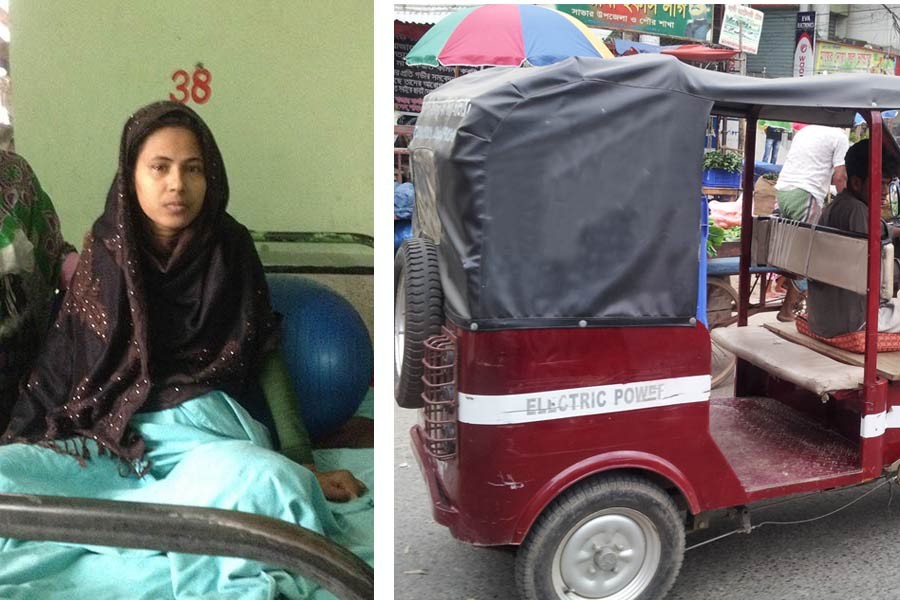All but one of 43 individuals victimised by the battery-run easy bikes are women.
The appalling information has been divulged during a recent investigation conducted by FE after the victims got admitted to the Centre for the Rehabilitation of Paralysed (CRP) in Savar.
This also exposes the death trap the electric cell-run three-wheeler poses, especially for the females who face such an accident usually with their scarves tangled in the vehicle, sources concerned say.
Kaniz Fatema, 30, a community health service provider, was returning home on April 1 this year.
She had lost her husband in an accident barely a month ago and was pregnant at the time.
She paid a brief visit to her husband's grave on that day before joining a meeting at her office.
After her office hours, she was heading back home with her 7-year old daughter riding in an easy-bike (electric cell-run three-wheeler).
Fatema, who hails from Naogaon of Rajshahi, knew nothing about the imminent danger that would soon turn into a recurring nightmare.
After going a few blocks, she felt a sudden, strong pull at her neck.
Fatema’s daughter and the easy-bike driver found that one end of Fatema's urna, which she draped around her neck, went through a gap between the driver's seat and the passenger seat.
The rotating motor, visible between the gap, caught her urna from nowhere and created an immense tugging force at her neck making her numb from neck down.
People rushed her to Rajshahi medical hospital immediately. After getting primary treatment Fatema was referred to Centre for the Rehabilitation of Paralysed (CRP) in Savar.
Since she was pregnant, the doctors at CRP sent her to a private hospital. Giving birth to her second child there, she was again transferred to CRP for further treatment.
Fatema is one of the 43 patients who was enlisted as scarf-victim since 2014, according to a study by CRP.
Like Fatema, Mukta Rani, 14, and Jhumu Islam, 16, bore the brunt of same misery at CRP.
Dr Israt Zahan Urmee of CRP said not only movement and sensation of the limb muscles of scarf-victims get affected, but also control over urination and defecation might get lost.
“We get two types of patients: complete-case and incomplete-case”, she said.
When the spinal cord shatters completely, there is no possibility of recovery; such injuries are called complete case, she explained.
Patients of incomplete case, however, have some nerves impaired and the hands may retain some sensation, she added.
CRP’s statistics of the last five years show that most victims were admitted at CRP with complete-case.
Patients need a treatment for at least three to six months to consider final stage, and Tk 0.15 million (150,000) as initial treatment cost, according to CRP.
The abrupt and strong yank on an easy-bike displaces lower vertebras of the cervical region of the spinal cord, said Muhammed Shahriar Zaman, Research Officer at CRP.
Injury to the spinal cord - the communication system between brain and body, could leave a person paralysed for life, he added.
CRP has already taken certain initiatives to stop the untoward incidents from happening.
It has been arranging awareness programmes and short films screenings in educational institutions.
Most importantly, it has started free distribution of wood sticks to plug in the gap on easy bikes, informed CRP’s publication and communication officer Roksana Parvin.
In conjunction, the government must take strong actions to regulate such unsafe vehicle, she urged.
Easy-bike imports from China are on the rise. The imported vehicles are seen plying the local roads, despite restrictions from court and Bangladesh Road Transport Authority (BRTA) on the operation of such vehicles.
“BRTA cannot provide licences, route permits and fitness certificates as easy-bike is not engine-run vehicle,” said BRTA’s assistant director of admin Md Reazur Rahman.
It is up to the road transport and bridge ministry to decide whether the operation of easy-bike would be legalised or not, he added.
In 2011, the government took a decision to withdraw easy-bikes gradually. The plan, however, is yet to be executed.


